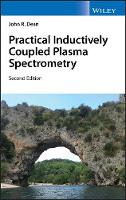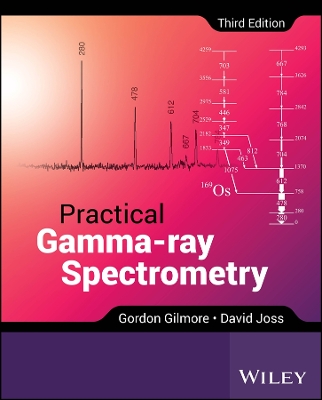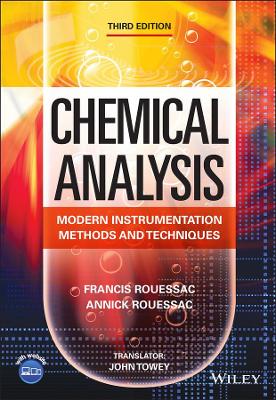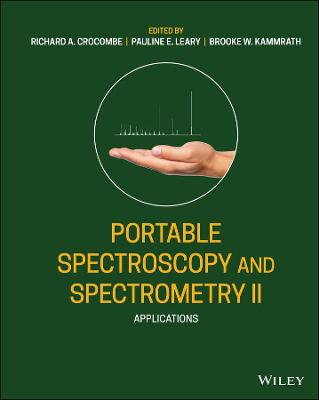Practical Inductively Coupled Plasma Spectrometry
 -15%
portes grátis
-15%
portes grátis
Practical Inductively Coupled Plasma Spectrometry
Dean, John R.
John Wiley & Sons Inc
04/2019
248
Dura
Inglês
9781119478683
15 a 20 dias
538
Descrição não disponível.
About the Author xiii
Preface xv
Acknowledgements xix
Acronyms, Abbreviations and Symbols xxiii
1 The Analytical Approach 1
1.1 Introduction 1
1.2 Essentials of Practical Work 2
1.3 Health and Safety 3
1.4 SI Units and Their Use 4
1.5 Significant Figures 11
1.6 Calibration and Quantitative Analysis 12
1.7 Making Notes of Practical Work and Observations 13
1.8 Data Analysis 14
1.9 Data Treatment 17
1.10 Data Quality 18
1.11 Data Interpretation and Context 21
1.12 Analytical Terms and Their Definitions 21
1.13 Summary 26
2 Sampling and Storage 27
2.1 Introduction 27
2.2 Sampling Soil 28
2.3 Sampling Water 31
2.4 Sampling Air 32
2.5 Sample Storage 34
2.6 Sample Preservation 36
2.7 Summary 37
3 Sample Preparation 39
3.1 Introduction 39
3.2 Aqueous Samples 40
3.2.1 Liquid-Liquid Extraction 40
3.2.1.1 Procedure for APDC Extraction in to MIBK 42
3.2.2 Ion Exchange 42
3.2.2.1 Procedure for Batch Ion Exchange Extraction 43
3.3 Solid Samples 43
3.3.1 Decomposition Techniques 45
3.3.1.1 Procedure for Acid Digestion A 46
3.3.1.2 Procedure for Acid Digestion B 46
3.3.1.3 Procedure for Microwave Acid Digestion 49
3.3.2 Alternate Decomposition Techniques 49
3.3.2.1 Procedure for Dry Ashing 49
3.3.2.2 Procedure for Fusion 50
3.4 Extraction Procedures 51
3.4.1 Procedure for Extractable Mercury from Soil and Sediment 52
3.4.2 Procedure for Speciation of Extractable Mercury from Soil and Sediment 52
3.4.3 Procedure for Arsenic Species Extraction 52
3.4.4 Single Extraction Methods 57
3.4.4.1 Procedure for EDTA Extraction 57
3.4.4.2 Procedure for AA Extraction 58
3.4.4.3 Procedure for Diethylenetriaminepentaacetic Acid (DTPA) Extraction 58
3.4.4.4 Procedure for Calcium Chloride (CaCl2) Extraction 58
3.4.4.5 Procedure for Ammonium Nitrate (NH4NO3) Extraction 59
3.4.4.6 Procedure for Sodium Nitrate (NaNO3) Extraction 60
3.4.5 Sequential Extraction 60
3.4.5.1 Procedure for Stage 1 Extraction 62
3.4.5.2 Procedure for Stage 2 Extraction 62
3.4.5.3 Procedure for Stage 3 Extraction 63
3.4.6 CISED 63
3.4.6.1 Procedure for CISED 64
3.4.7 In Vitro Gastrointestinal Extraction Method 65
3.4.7.1 Procedure for Gastric Extraction 66
3.4.7.2 Procedure for Gastric + Intestinal Extraction 67
3.4.8 In Vitro Simulated Epithelium Lung Fluid Method 67
3.4.8.1 Procedure for Inhalation Bioaccessibility Extraction 69
3.5 Summary 69
Reference 69
3.A Extraction Reagents for Single Extraction Methods 70
3.A.1 Preparation of EDTA, 50 mM 70
3.A.2 Preparation of AA, 0.43 M 70
3.A.3 Preparation of Diethylenetriaminepentaacetic Acid (DTPA), 5 mM 70
3.A.4 Preparation of Ammonium Nitrate (NH4NO3), 1 M 70
3.A.5 Preparation of Calcium Chloride (CaCl2), 0.01 M 70
3.A.6 Preparation of Sodium Nitrate (NaNO3), 0.1 M 71
3.B Extraction Reagents for the Sequential Extraction Method 71
3.B.1 Preparation of Solution A (Acetic Acid, 0.11 M) 71
3.B.2 Preparation of Solution B (Hydroxylamine Hydrochloride or Hydroxyammonium Chloride, 0.5 M) 71
3.B.3 Preparation of Solution C (Hydrogen Peroxide [300 mg g?1], 8.8 M) 71
3.B.4 Preparation of Solution D (Ammonium Acetate, 1 M) 71
3.C Extraction Reagents for the Unified Bioaccessibility Method 72
3.C.1 Preparation of Simulated Saliva Fluid 72
3.C.2 Preparation of Simulated Gastric Fluid 72
3.C.3 Preparation of Simulated Duodenal Fluid 72
3.C.4 Preparation of Simulated Bile Fluid 73
3.D Extraction Reagents for the In Vitro SELF 73
3.D.1 Preparation of SELF 73
4 Sample Introduction 75
4.1 Introduction 75
4.2 Nebulizers 76
4.3 Spray Chambers and Desolvation Systems 79
4.4 Discrete Sample Introduction 83
4.5 Continuous Sample Introduction 87
4.6 Hydride and Cold-Vapour Generation Techniques 91
4.7 Summary 93
References 93
5 The Inductively Coupled Plasma 95
5.1 Introduction 95
5.2 Radiofrequency Generators 96
5.3 Inductively Coupled Plasma Formation and Operation 96
5.4 Processes Within the ICP 106
5.5 Signal Processing and Instrument Control 106
5.6 Summary 107
References 108
6 Inductively Coupled Plasma-Atomic Emission Spectrometry 109
6.1 Introduction 110
6.2 Fundamentals of Spectroscopy 110
6.2.1 Origins of Atomic Spectra 111
6.2.2 Spectral Line Intensity 113
6.2.3 Spectral Line Broadening 114
6.3 Plasma Spectroscopy 116
6.4 Spectrometers 118
6.4.1 Sequential Spectrometer 122
6.4.2 Simultaneous Spectrometers 122
6.5 Detectors 125
6.5.1 Photomultiplier Tube 127
6.5.2 Charge-Transfer Devices 128
6.6 Interferences 130
6.7 Summary 131
References 132
7 Inductively Coupled Plasma-Mass Spectrometry 133
7.1 Introduction 133
7.2 Fundamentals of Mass Spectrometry 134
7.2.1 Some Terminology 134
7.3 Inorganic Mass Spectrometry 135
7.3.1 The Ion Source: ICP 137
7.3.2 The Interface 138
7.4 Mass Spectrometers 139
7.4.1 Quadrupole Mass Spectrometer 140
7.4.2 High-Resolution Mass Spectrometers 142
7.4.3 Ion-Trap Mass Spectrometer 150
7.4.4 Time-of-Flight Mass Spectrometer 152
7.5 Detectors 153
7.6 Interferences 156
7.6.1 Isobaric Interferences 156
7.6.2 Molecular Interferences 158
7.6.3 Remedies for Molecular Interferences 161
7.6.3.1 Charge Transfer 161
7.6.3.2 Proton Transfer 162
7.6.3.3 Hydrogen-Atom Transfer 162
7.6.3.4 Atom Transfer 162
7.6.3.5 Adduct Formation 162
7.6.4 Non-Spectral Interferences: Matrix-Induced 164
7.7 Isotope Dilution Analysis 165
7.8 Summary 176
References 176
8 Inductively Coupled Plasma: Current and Future Developments 177
8.1 Introduction 177
8.2 Comparison of ICP-AES and ICP-MS 177
8.3 Applications 182
8.4 Current and Future Developments 183
8.4.1 In General, for the ICP 184
8.4.2 For ICP-MS 185
8.4.3 For ICP-AES 189
8.5 Useful Resources 191
References 198
Further Reading 198
9 Inductively Coupled Plasma: Troubleshooting and Maintenance 201
9.1 Introduction 201
9.2 Diagnostic Issues 201
9.3 Tips to Reduce... 202
9.3.1 Potential Autosampler Issues 202
9.3.2 Contamination 202
9.4 Tips to Improve... 203
9.4.1 Sample Preparation 203
9.5 How To ... 203
9.5.1 Unblock a Blocked Pneumatic Concentric Nebulizer 203
9.5.2 Clean the Spray Chamber 203
9.5.3 Clean the Plasma Torch 204
9.6 What to do About... 204
9.6.1 Plasma Ignition Problems 204
9.7 Shut Down Procedure (At the End of the Day) 204
9.8 Regular Maintenance Schedule 205
The Periodic Table 207
SI Units and Physical Constants 209
Index 213
Preface xv
Acknowledgements xix
Acronyms, Abbreviations and Symbols xxiii
1 The Analytical Approach 1
1.1 Introduction 1
1.2 Essentials of Practical Work 2
1.3 Health and Safety 3
1.4 SI Units and Their Use 4
1.5 Significant Figures 11
1.6 Calibration and Quantitative Analysis 12
1.7 Making Notes of Practical Work and Observations 13
1.8 Data Analysis 14
1.9 Data Treatment 17
1.10 Data Quality 18
1.11 Data Interpretation and Context 21
1.12 Analytical Terms and Their Definitions 21
1.13 Summary 26
2 Sampling and Storage 27
2.1 Introduction 27
2.2 Sampling Soil 28
2.3 Sampling Water 31
2.4 Sampling Air 32
2.5 Sample Storage 34
2.6 Sample Preservation 36
2.7 Summary 37
3 Sample Preparation 39
3.1 Introduction 39
3.2 Aqueous Samples 40
3.2.1 Liquid-Liquid Extraction 40
3.2.1.1 Procedure for APDC Extraction in to MIBK 42
3.2.2 Ion Exchange 42
3.2.2.1 Procedure for Batch Ion Exchange Extraction 43
3.3 Solid Samples 43
3.3.1 Decomposition Techniques 45
3.3.1.1 Procedure for Acid Digestion A 46
3.3.1.2 Procedure for Acid Digestion B 46
3.3.1.3 Procedure for Microwave Acid Digestion 49
3.3.2 Alternate Decomposition Techniques 49
3.3.2.1 Procedure for Dry Ashing 49
3.3.2.2 Procedure for Fusion 50
3.4 Extraction Procedures 51
3.4.1 Procedure for Extractable Mercury from Soil and Sediment 52
3.4.2 Procedure for Speciation of Extractable Mercury from Soil and Sediment 52
3.4.3 Procedure for Arsenic Species Extraction 52
3.4.4 Single Extraction Methods 57
3.4.4.1 Procedure for EDTA Extraction 57
3.4.4.2 Procedure for AA Extraction 58
3.4.4.3 Procedure for Diethylenetriaminepentaacetic Acid (DTPA) Extraction 58
3.4.4.4 Procedure for Calcium Chloride (CaCl2) Extraction 58
3.4.4.5 Procedure for Ammonium Nitrate (NH4NO3) Extraction 59
3.4.4.6 Procedure for Sodium Nitrate (NaNO3) Extraction 60
3.4.5 Sequential Extraction 60
3.4.5.1 Procedure for Stage 1 Extraction 62
3.4.5.2 Procedure for Stage 2 Extraction 62
3.4.5.3 Procedure for Stage 3 Extraction 63
3.4.6 CISED 63
3.4.6.1 Procedure for CISED 64
3.4.7 In Vitro Gastrointestinal Extraction Method 65
3.4.7.1 Procedure for Gastric Extraction 66
3.4.7.2 Procedure for Gastric + Intestinal Extraction 67
3.4.8 In Vitro Simulated Epithelium Lung Fluid Method 67
3.4.8.1 Procedure for Inhalation Bioaccessibility Extraction 69
3.5 Summary 69
Reference 69
3.A Extraction Reagents for Single Extraction Methods 70
3.A.1 Preparation of EDTA, 50 mM 70
3.A.2 Preparation of AA, 0.43 M 70
3.A.3 Preparation of Diethylenetriaminepentaacetic Acid (DTPA), 5 mM 70
3.A.4 Preparation of Ammonium Nitrate (NH4NO3), 1 M 70
3.A.5 Preparation of Calcium Chloride (CaCl2), 0.01 M 70
3.A.6 Preparation of Sodium Nitrate (NaNO3), 0.1 M 71
3.B Extraction Reagents for the Sequential Extraction Method 71
3.B.1 Preparation of Solution A (Acetic Acid, 0.11 M) 71
3.B.2 Preparation of Solution B (Hydroxylamine Hydrochloride or Hydroxyammonium Chloride, 0.5 M) 71
3.B.3 Preparation of Solution C (Hydrogen Peroxide [300 mg g?1], 8.8 M) 71
3.B.4 Preparation of Solution D (Ammonium Acetate, 1 M) 71
3.C Extraction Reagents for the Unified Bioaccessibility Method 72
3.C.1 Preparation of Simulated Saliva Fluid 72
3.C.2 Preparation of Simulated Gastric Fluid 72
3.C.3 Preparation of Simulated Duodenal Fluid 72
3.C.4 Preparation of Simulated Bile Fluid 73
3.D Extraction Reagents for the In Vitro SELF 73
3.D.1 Preparation of SELF 73
4 Sample Introduction 75
4.1 Introduction 75
4.2 Nebulizers 76
4.3 Spray Chambers and Desolvation Systems 79
4.4 Discrete Sample Introduction 83
4.5 Continuous Sample Introduction 87
4.6 Hydride and Cold-Vapour Generation Techniques 91
4.7 Summary 93
References 93
5 The Inductively Coupled Plasma 95
5.1 Introduction 95
5.2 Radiofrequency Generators 96
5.3 Inductively Coupled Plasma Formation and Operation 96
5.4 Processes Within the ICP 106
5.5 Signal Processing and Instrument Control 106
5.6 Summary 107
References 108
6 Inductively Coupled Plasma-Atomic Emission Spectrometry 109
6.1 Introduction 110
6.2 Fundamentals of Spectroscopy 110
6.2.1 Origins of Atomic Spectra 111
6.2.2 Spectral Line Intensity 113
6.2.3 Spectral Line Broadening 114
6.3 Plasma Spectroscopy 116
6.4 Spectrometers 118
6.4.1 Sequential Spectrometer 122
6.4.2 Simultaneous Spectrometers 122
6.5 Detectors 125
6.5.1 Photomultiplier Tube 127
6.5.2 Charge-Transfer Devices 128
6.6 Interferences 130
6.7 Summary 131
References 132
7 Inductively Coupled Plasma-Mass Spectrometry 133
7.1 Introduction 133
7.2 Fundamentals of Mass Spectrometry 134
7.2.1 Some Terminology 134
7.3 Inorganic Mass Spectrometry 135
7.3.1 The Ion Source: ICP 137
7.3.2 The Interface 138
7.4 Mass Spectrometers 139
7.4.1 Quadrupole Mass Spectrometer 140
7.4.2 High-Resolution Mass Spectrometers 142
7.4.3 Ion-Trap Mass Spectrometer 150
7.4.4 Time-of-Flight Mass Spectrometer 152
7.5 Detectors 153
7.6 Interferences 156
7.6.1 Isobaric Interferences 156
7.6.2 Molecular Interferences 158
7.6.3 Remedies for Molecular Interferences 161
7.6.3.1 Charge Transfer 161
7.6.3.2 Proton Transfer 162
7.6.3.3 Hydrogen-Atom Transfer 162
7.6.3.4 Atom Transfer 162
7.6.3.5 Adduct Formation 162
7.6.4 Non-Spectral Interferences: Matrix-Induced 164
7.7 Isotope Dilution Analysis 165
7.8 Summary 176
References 176
8 Inductively Coupled Plasma: Current and Future Developments 177
8.1 Introduction 177
8.2 Comparison of ICP-AES and ICP-MS 177
8.3 Applications 182
8.4 Current and Future Developments 183
8.4.1 In General, for the ICP 184
8.4.2 For ICP-MS 185
8.4.3 For ICP-AES 189
8.5 Useful Resources 191
References 198
Further Reading 198
9 Inductively Coupled Plasma: Troubleshooting and Maintenance 201
9.1 Introduction 201
9.2 Diagnostic Issues 201
9.3 Tips to Reduce... 202
9.3.1 Potential Autosampler Issues 202
9.3.2 Contamination 202
9.4 Tips to Improve... 203
9.4.1 Sample Preparation 203
9.5 How To ... 203
9.5.1 Unblock a Blocked Pneumatic Concentric Nebulizer 203
9.5.2 Clean the Spray Chamber 203
9.5.3 Clean the Plasma Torch 204
9.6 What to do About... 204
9.6.1 Plasma Ignition Problems 204
9.7 Shut Down Procedure (At the End of the Day) 204
9.8 Regular Maintenance Schedule 205
The Periodic Table 207
SI Units and Physical Constants 209
Index 213
Este título pertence ao(s) assunto(s) indicados(s). Para ver outros títulos clique no assunto desejado.
Plasma Spectrometry; Aqueous samples; Solid samples; Sample extraction; Selective chemical extraction; Decomposition techniques; Chemometric identification; in-vitro gastrointestinal extraction; in-vitro epithelium lung fluid extraction; ICP-AES; ICP-MS; Instrumentation; Spectrometer design and application; Detection; Data treatment
About the Author xiii
Preface xv
Acknowledgements xix
Acronyms, Abbreviations and Symbols xxiii
1 The Analytical Approach 1
1.1 Introduction 1
1.2 Essentials of Practical Work 2
1.3 Health and Safety 3
1.4 SI Units and Their Use 4
1.5 Significant Figures 11
1.6 Calibration and Quantitative Analysis 12
1.7 Making Notes of Practical Work and Observations 13
1.8 Data Analysis 14
1.9 Data Treatment 17
1.10 Data Quality 18
1.11 Data Interpretation and Context 21
1.12 Analytical Terms and Their Definitions 21
1.13 Summary 26
2 Sampling and Storage 27
2.1 Introduction 27
2.2 Sampling Soil 28
2.3 Sampling Water 31
2.4 Sampling Air 32
2.5 Sample Storage 34
2.6 Sample Preservation 36
2.7 Summary 37
3 Sample Preparation 39
3.1 Introduction 39
3.2 Aqueous Samples 40
3.2.1 Liquid-Liquid Extraction 40
3.2.1.1 Procedure for APDC Extraction in to MIBK 42
3.2.2 Ion Exchange 42
3.2.2.1 Procedure for Batch Ion Exchange Extraction 43
3.3 Solid Samples 43
3.3.1 Decomposition Techniques 45
3.3.1.1 Procedure for Acid Digestion A 46
3.3.1.2 Procedure for Acid Digestion B 46
3.3.1.3 Procedure for Microwave Acid Digestion 49
3.3.2 Alternate Decomposition Techniques 49
3.3.2.1 Procedure for Dry Ashing 49
3.3.2.2 Procedure for Fusion 50
3.4 Extraction Procedures 51
3.4.1 Procedure for Extractable Mercury from Soil and Sediment 52
3.4.2 Procedure for Speciation of Extractable Mercury from Soil and Sediment 52
3.4.3 Procedure for Arsenic Species Extraction 52
3.4.4 Single Extraction Methods 57
3.4.4.1 Procedure for EDTA Extraction 57
3.4.4.2 Procedure for AA Extraction 58
3.4.4.3 Procedure for Diethylenetriaminepentaacetic Acid (DTPA) Extraction 58
3.4.4.4 Procedure for Calcium Chloride (CaCl2) Extraction 58
3.4.4.5 Procedure for Ammonium Nitrate (NH4NO3) Extraction 59
3.4.4.6 Procedure for Sodium Nitrate (NaNO3) Extraction 60
3.4.5 Sequential Extraction 60
3.4.5.1 Procedure for Stage 1 Extraction 62
3.4.5.2 Procedure for Stage 2 Extraction 62
3.4.5.3 Procedure for Stage 3 Extraction 63
3.4.6 CISED 63
3.4.6.1 Procedure for CISED 64
3.4.7 In Vitro Gastrointestinal Extraction Method 65
3.4.7.1 Procedure for Gastric Extraction 66
3.4.7.2 Procedure for Gastric + Intestinal Extraction 67
3.4.8 In Vitro Simulated Epithelium Lung Fluid Method 67
3.4.8.1 Procedure for Inhalation Bioaccessibility Extraction 69
3.5 Summary 69
Reference 69
3.A Extraction Reagents for Single Extraction Methods 70
3.A.1 Preparation of EDTA, 50 mM 70
3.A.2 Preparation of AA, 0.43 M 70
3.A.3 Preparation of Diethylenetriaminepentaacetic Acid (DTPA), 5 mM 70
3.A.4 Preparation of Ammonium Nitrate (NH4NO3), 1 M 70
3.A.5 Preparation of Calcium Chloride (CaCl2), 0.01 M 70
3.A.6 Preparation of Sodium Nitrate (NaNO3), 0.1 M 71
3.B Extraction Reagents for the Sequential Extraction Method 71
3.B.1 Preparation of Solution A (Acetic Acid, 0.11 M) 71
3.B.2 Preparation of Solution B (Hydroxylamine Hydrochloride or Hydroxyammonium Chloride, 0.5 M) 71
3.B.3 Preparation of Solution C (Hydrogen Peroxide [300 mg g?1], 8.8 M) 71
3.B.4 Preparation of Solution D (Ammonium Acetate, 1 M) 71
3.C Extraction Reagents for the Unified Bioaccessibility Method 72
3.C.1 Preparation of Simulated Saliva Fluid 72
3.C.2 Preparation of Simulated Gastric Fluid 72
3.C.3 Preparation of Simulated Duodenal Fluid 72
3.C.4 Preparation of Simulated Bile Fluid 73
3.D Extraction Reagents for the In Vitro SELF 73
3.D.1 Preparation of SELF 73
4 Sample Introduction 75
4.1 Introduction 75
4.2 Nebulizers 76
4.3 Spray Chambers and Desolvation Systems 79
4.4 Discrete Sample Introduction 83
4.5 Continuous Sample Introduction 87
4.6 Hydride and Cold-Vapour Generation Techniques 91
4.7 Summary 93
References 93
5 The Inductively Coupled Plasma 95
5.1 Introduction 95
5.2 Radiofrequency Generators 96
5.3 Inductively Coupled Plasma Formation and Operation 96
5.4 Processes Within the ICP 106
5.5 Signal Processing and Instrument Control 106
5.6 Summary 107
References 108
6 Inductively Coupled Plasma-Atomic Emission Spectrometry 109
6.1 Introduction 110
6.2 Fundamentals of Spectroscopy 110
6.2.1 Origins of Atomic Spectra 111
6.2.2 Spectral Line Intensity 113
6.2.3 Spectral Line Broadening 114
6.3 Plasma Spectroscopy 116
6.4 Spectrometers 118
6.4.1 Sequential Spectrometer 122
6.4.2 Simultaneous Spectrometers 122
6.5 Detectors 125
6.5.1 Photomultiplier Tube 127
6.5.2 Charge-Transfer Devices 128
6.6 Interferences 130
6.7 Summary 131
References 132
7 Inductively Coupled Plasma-Mass Spectrometry 133
7.1 Introduction 133
7.2 Fundamentals of Mass Spectrometry 134
7.2.1 Some Terminology 134
7.3 Inorganic Mass Spectrometry 135
7.3.1 The Ion Source: ICP 137
7.3.2 The Interface 138
7.4 Mass Spectrometers 139
7.4.1 Quadrupole Mass Spectrometer 140
7.4.2 High-Resolution Mass Spectrometers 142
7.4.3 Ion-Trap Mass Spectrometer 150
7.4.4 Time-of-Flight Mass Spectrometer 152
7.5 Detectors 153
7.6 Interferences 156
7.6.1 Isobaric Interferences 156
7.6.2 Molecular Interferences 158
7.6.3 Remedies for Molecular Interferences 161
7.6.3.1 Charge Transfer 161
7.6.3.2 Proton Transfer 162
7.6.3.3 Hydrogen-Atom Transfer 162
7.6.3.4 Atom Transfer 162
7.6.3.5 Adduct Formation 162
7.6.4 Non-Spectral Interferences: Matrix-Induced 164
7.7 Isotope Dilution Analysis 165
7.8 Summary 176
References 176
8 Inductively Coupled Plasma: Current and Future Developments 177
8.1 Introduction 177
8.2 Comparison of ICP-AES and ICP-MS 177
8.3 Applications 182
8.4 Current and Future Developments 183
8.4.1 In General, for the ICP 184
8.4.2 For ICP-MS 185
8.4.3 For ICP-AES 189
8.5 Useful Resources 191
References 198
Further Reading 198
9 Inductively Coupled Plasma: Troubleshooting and Maintenance 201
9.1 Introduction 201
9.2 Diagnostic Issues 201
9.3 Tips to Reduce... 202
9.3.1 Potential Autosampler Issues 202
9.3.2 Contamination 202
9.4 Tips to Improve... 203
9.4.1 Sample Preparation 203
9.5 How To ... 203
9.5.1 Unblock a Blocked Pneumatic Concentric Nebulizer 203
9.5.2 Clean the Spray Chamber 203
9.5.3 Clean the Plasma Torch 204
9.6 What to do About... 204
9.6.1 Plasma Ignition Problems 204
9.7 Shut Down Procedure (At the End of the Day) 204
9.8 Regular Maintenance Schedule 205
The Periodic Table 207
SI Units and Physical Constants 209
Index 213
Preface xv
Acknowledgements xix
Acronyms, Abbreviations and Symbols xxiii
1 The Analytical Approach 1
1.1 Introduction 1
1.2 Essentials of Practical Work 2
1.3 Health and Safety 3
1.4 SI Units and Their Use 4
1.5 Significant Figures 11
1.6 Calibration and Quantitative Analysis 12
1.7 Making Notes of Practical Work and Observations 13
1.8 Data Analysis 14
1.9 Data Treatment 17
1.10 Data Quality 18
1.11 Data Interpretation and Context 21
1.12 Analytical Terms and Their Definitions 21
1.13 Summary 26
2 Sampling and Storage 27
2.1 Introduction 27
2.2 Sampling Soil 28
2.3 Sampling Water 31
2.4 Sampling Air 32
2.5 Sample Storage 34
2.6 Sample Preservation 36
2.7 Summary 37
3 Sample Preparation 39
3.1 Introduction 39
3.2 Aqueous Samples 40
3.2.1 Liquid-Liquid Extraction 40
3.2.1.1 Procedure for APDC Extraction in to MIBK 42
3.2.2 Ion Exchange 42
3.2.2.1 Procedure for Batch Ion Exchange Extraction 43
3.3 Solid Samples 43
3.3.1 Decomposition Techniques 45
3.3.1.1 Procedure for Acid Digestion A 46
3.3.1.2 Procedure for Acid Digestion B 46
3.3.1.3 Procedure for Microwave Acid Digestion 49
3.3.2 Alternate Decomposition Techniques 49
3.3.2.1 Procedure for Dry Ashing 49
3.3.2.2 Procedure for Fusion 50
3.4 Extraction Procedures 51
3.4.1 Procedure for Extractable Mercury from Soil and Sediment 52
3.4.2 Procedure for Speciation of Extractable Mercury from Soil and Sediment 52
3.4.3 Procedure for Arsenic Species Extraction 52
3.4.4 Single Extraction Methods 57
3.4.4.1 Procedure for EDTA Extraction 57
3.4.4.2 Procedure for AA Extraction 58
3.4.4.3 Procedure for Diethylenetriaminepentaacetic Acid (DTPA) Extraction 58
3.4.4.4 Procedure for Calcium Chloride (CaCl2) Extraction 58
3.4.4.5 Procedure for Ammonium Nitrate (NH4NO3) Extraction 59
3.4.4.6 Procedure for Sodium Nitrate (NaNO3) Extraction 60
3.4.5 Sequential Extraction 60
3.4.5.1 Procedure for Stage 1 Extraction 62
3.4.5.2 Procedure for Stage 2 Extraction 62
3.4.5.3 Procedure for Stage 3 Extraction 63
3.4.6 CISED 63
3.4.6.1 Procedure for CISED 64
3.4.7 In Vitro Gastrointestinal Extraction Method 65
3.4.7.1 Procedure for Gastric Extraction 66
3.4.7.2 Procedure for Gastric + Intestinal Extraction 67
3.4.8 In Vitro Simulated Epithelium Lung Fluid Method 67
3.4.8.1 Procedure for Inhalation Bioaccessibility Extraction 69
3.5 Summary 69
Reference 69
3.A Extraction Reagents for Single Extraction Methods 70
3.A.1 Preparation of EDTA, 50 mM 70
3.A.2 Preparation of AA, 0.43 M 70
3.A.3 Preparation of Diethylenetriaminepentaacetic Acid (DTPA), 5 mM 70
3.A.4 Preparation of Ammonium Nitrate (NH4NO3), 1 M 70
3.A.5 Preparation of Calcium Chloride (CaCl2), 0.01 M 70
3.A.6 Preparation of Sodium Nitrate (NaNO3), 0.1 M 71
3.B Extraction Reagents for the Sequential Extraction Method 71
3.B.1 Preparation of Solution A (Acetic Acid, 0.11 M) 71
3.B.2 Preparation of Solution B (Hydroxylamine Hydrochloride or Hydroxyammonium Chloride, 0.5 M) 71
3.B.3 Preparation of Solution C (Hydrogen Peroxide [300 mg g?1], 8.8 M) 71
3.B.4 Preparation of Solution D (Ammonium Acetate, 1 M) 71
3.C Extraction Reagents for the Unified Bioaccessibility Method 72
3.C.1 Preparation of Simulated Saliva Fluid 72
3.C.2 Preparation of Simulated Gastric Fluid 72
3.C.3 Preparation of Simulated Duodenal Fluid 72
3.C.4 Preparation of Simulated Bile Fluid 73
3.D Extraction Reagents for the In Vitro SELF 73
3.D.1 Preparation of SELF 73
4 Sample Introduction 75
4.1 Introduction 75
4.2 Nebulizers 76
4.3 Spray Chambers and Desolvation Systems 79
4.4 Discrete Sample Introduction 83
4.5 Continuous Sample Introduction 87
4.6 Hydride and Cold-Vapour Generation Techniques 91
4.7 Summary 93
References 93
5 The Inductively Coupled Plasma 95
5.1 Introduction 95
5.2 Radiofrequency Generators 96
5.3 Inductively Coupled Plasma Formation and Operation 96
5.4 Processes Within the ICP 106
5.5 Signal Processing and Instrument Control 106
5.6 Summary 107
References 108
6 Inductively Coupled Plasma-Atomic Emission Spectrometry 109
6.1 Introduction 110
6.2 Fundamentals of Spectroscopy 110
6.2.1 Origins of Atomic Spectra 111
6.2.2 Spectral Line Intensity 113
6.2.3 Spectral Line Broadening 114
6.3 Plasma Spectroscopy 116
6.4 Spectrometers 118
6.4.1 Sequential Spectrometer 122
6.4.2 Simultaneous Spectrometers 122
6.5 Detectors 125
6.5.1 Photomultiplier Tube 127
6.5.2 Charge-Transfer Devices 128
6.6 Interferences 130
6.7 Summary 131
References 132
7 Inductively Coupled Plasma-Mass Spectrometry 133
7.1 Introduction 133
7.2 Fundamentals of Mass Spectrometry 134
7.2.1 Some Terminology 134
7.3 Inorganic Mass Spectrometry 135
7.3.1 The Ion Source: ICP 137
7.3.2 The Interface 138
7.4 Mass Spectrometers 139
7.4.1 Quadrupole Mass Spectrometer 140
7.4.2 High-Resolution Mass Spectrometers 142
7.4.3 Ion-Trap Mass Spectrometer 150
7.4.4 Time-of-Flight Mass Spectrometer 152
7.5 Detectors 153
7.6 Interferences 156
7.6.1 Isobaric Interferences 156
7.6.2 Molecular Interferences 158
7.6.3 Remedies for Molecular Interferences 161
7.6.3.1 Charge Transfer 161
7.6.3.2 Proton Transfer 162
7.6.3.3 Hydrogen-Atom Transfer 162
7.6.3.4 Atom Transfer 162
7.6.3.5 Adduct Formation 162
7.6.4 Non-Spectral Interferences: Matrix-Induced 164
7.7 Isotope Dilution Analysis 165
7.8 Summary 176
References 176
8 Inductively Coupled Plasma: Current and Future Developments 177
8.1 Introduction 177
8.2 Comparison of ICP-AES and ICP-MS 177
8.3 Applications 182
8.4 Current and Future Developments 183
8.4.1 In General, for the ICP 184
8.4.2 For ICP-MS 185
8.4.3 For ICP-AES 189
8.5 Useful Resources 191
References 198
Further Reading 198
9 Inductively Coupled Plasma: Troubleshooting and Maintenance 201
9.1 Introduction 201
9.2 Diagnostic Issues 201
9.3 Tips to Reduce... 202
9.3.1 Potential Autosampler Issues 202
9.3.2 Contamination 202
9.4 Tips to Improve... 203
9.4.1 Sample Preparation 203
9.5 How To ... 203
9.5.1 Unblock a Blocked Pneumatic Concentric Nebulizer 203
9.5.2 Clean the Spray Chamber 203
9.5.3 Clean the Plasma Torch 204
9.6 What to do About... 204
9.6.1 Plasma Ignition Problems 204
9.7 Shut Down Procedure (At the End of the Day) 204
9.8 Regular Maintenance Schedule 205
The Periodic Table 207
SI Units and Physical Constants 209
Index 213
Este título pertence ao(s) assunto(s) indicados(s). Para ver outros títulos clique no assunto desejado.
Plasma Spectrometry; Aqueous samples; Solid samples; Sample extraction; Selective chemical extraction; Decomposition techniques; Chemometric identification; in-vitro gastrointestinal extraction; in-vitro epithelium lung fluid extraction; ICP-AES; ICP-MS; Instrumentation; Spectrometer design and application; Detection; Data treatment






